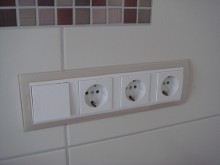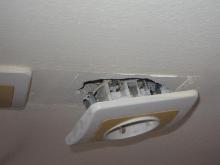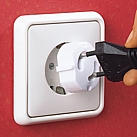Categories: Electrician at home, Electrical Reviews
Number of views: 86553
Comments on the article: 4
Sockets for home. Review and useful tips
 What electric socket, no one needs to explain. This is a fairly simple electrical device that allows you to connect various devices to the mains.
What electric socket, no one needs to explain. This is a fairly simple electrical device that allows you to connect various devices to the mains.
How to choose an electrical outlet so that it lasts faithfully for many years?
By design, almost all sockets are the same. As a rule, they consist of a case, a block, to which springy contacts and terminals are attached, to which, in fact, current-carrying wires are screwed.
Sockets are for industrial use, for connecting powerful, energy-intensive consumers. Such outlets, depending on the load, can be rated for current up to several hundred amperes. In this article we will consider household sockets.
 Most outlets used in everyday life can be divided into two main types, according to the installation method - overhead sockets and recessed sockets.
Most outlets used in everyday life can be divided into two main types, according to the installation method - overhead sockets and recessed sockets.
According to the rules, according to the PUE (rules for the installation of electrical installations), to prevent electric shock, a third grounding conductor must be connected to all electrical appliances, which, if a voltage potential appears on the case, removes this voltage to the ground. It complies with these rules ground outlet, in the design of which a third grounding contact is provided.
In houses that are not equipped with a gas pipeline, electric stoves are installed for cooking. The power of some electric stoves reaches 8 kW. In a standard 16 A socket, it is for such a current that the sockets in the apartment, house are designed, you can not turn on the electric stove. To connect such a powerful load, special electric sockets.
Standard sockets for electric stoves are designed for currents up to 40A, which, if converted to power in watts, corresponds to 8.5 kW. Plates of higher power are designed for connection to three-phase networks, and, as a rule, are not used in everyday life.
 Outlet Quality directly depends on the quality of the material from which the contacts are made. The contact plates installed in the socket mechanisms must be sufficiently elastic and strong, and at the same time flexible, so that the next time you try to pull the plug, the socket does not fall out of the wall.
Outlet Quality directly depends on the quality of the material from which the contacts are made. The contact plates installed in the socket mechanisms must be sufficiently elastic and strong, and at the same time flexible, so that the next time you try to pull the plug, the socket does not fall out of the wall.
Many, and almost all, remember that the sockets in apartments and houses, until recently, were installed a little different in shape than they are today. Sockets of the old model were designed to connect electrical appliances without grounding. The sockets for the load were calculated, the maximum current of which did not exceed 6.3 A. If a load of higher power was connected, there was a chance that, in the best case, the protection would work, well, if instead of a fuse they put a “bug”, an irreparable could happen - fire of the wiring and fire .
 To date, many have already made modern repairs with wiring replacement, which allowed the use of more powerful electrical appliances, which every day appears more. Some until recently in apartments, houses, stood external, external sockets. This, from the point of view of aesthetics, is not entirely beautiful, and uncomfortable.
To date, many have already made modern repairs with wiring replacement, which allowed the use of more powerful electrical appliances, which every day appears more. Some until recently in apartments, houses, stood external, external sockets. This, from the point of view of aesthetics, is not entirely beautiful, and uncomfortable.
After repair, almost everything is installed hidden ground outlets, that is, the sockets are flush with the wall. These outlets already comply with European standards. These 16A sockets are designed for a larger load than old-style sockets. You can connect devices up to 3.5 kW in such a socket, the main thing is to withstand wiring and circuit breakers in the switchboard.
In addition to the third, additional grounding contact, the sockets of the old, Soviet model differ from European standard sockets and the diameter of the holes for the plug from electrical appliances. In old sockets, the plug holes were 4 mm, in sockets corresponding to the European standard, holes with a larger diameter were 4.8 mm.
 In addition to conventional outlets with grounding, there are many more outlets that provide various mechanisms and devices that make the operation of devices as safe and convenient for the user as possible. But this is a topic for another article. In the market of electrical appliances there are a lot of sockets and switches of various manufacturers.
In addition to conventional outlets with grounding, there are many more outlets that provide various mechanisms and devices that make the operation of devices as safe and convenient for the user as possible. But this is a topic for another article. In the market of electrical appliances there are a lot of sockets and switches of various manufacturers.
In order not to make a mistake in choosing, consult with a professional electrician with experience, he will help you make the right choice.
As a rule, professionals know the pros and cons of sockets and switches from various manufacturers. In any case, trust the opinion of professionals.
Sergey Seromashenko
See also at bgv.electricianexp.com
:
